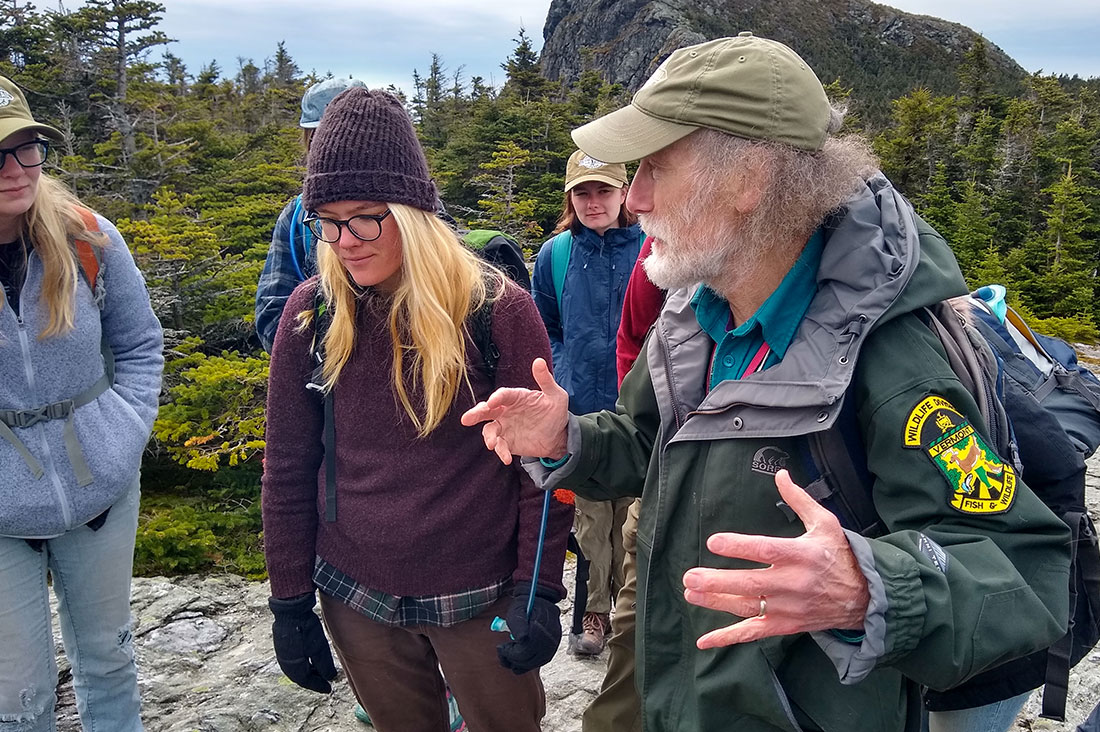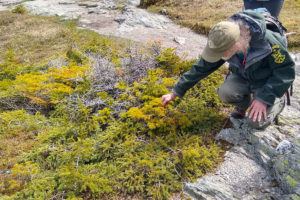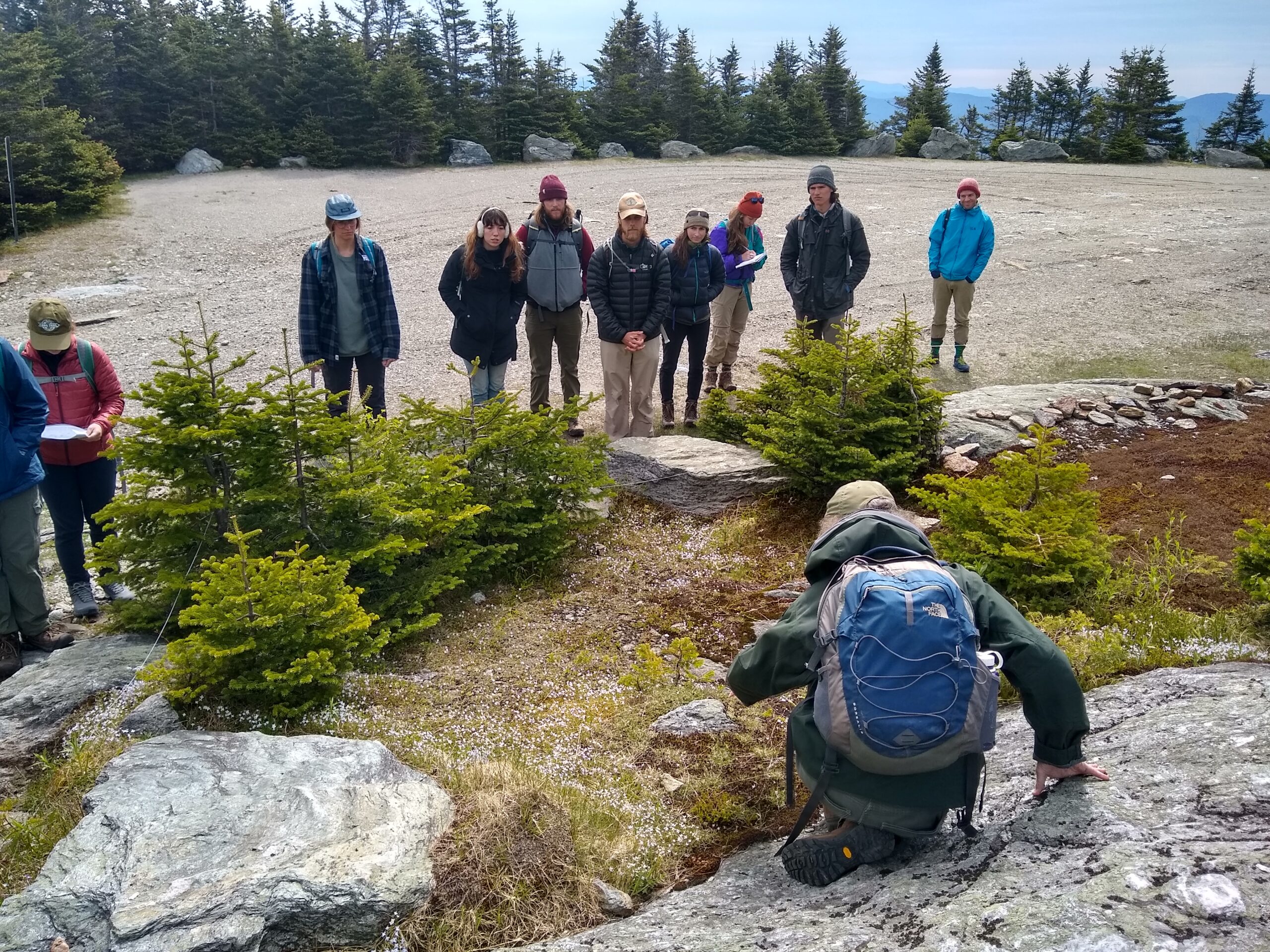
This article previously appeared in the Spring 2023 Long Trail News, under the headline “State Botanist Bob Popp, Instrumental in Caretaker Education, Retires.” It was written by Hailey Lynch, GMC’s Group Outreach and Field Coordinator through Vermont Housing and Conservation Board AmeriCorps.
Generations of Green Mountain Club backcountry caretakers know that spiky Bigelow’s Sedge isn’t just plain old grass, thanks to Bob Popp, who is retiring after 33 years as Vermont’s State Botanist. One element of his role has been leading annual alpine plant identification training sessions. Those sessions have been an essential part of the club’s effort to protect alpine rare and fragile vegetation on Vermont’s higher summits.
Each year, caretakers are humbled as they breathlessly chase Bob along the Mount Mansfield ridgeline, learning the differences between red and black spruce and the importance and special character of Vermont’s alpine vegetation.
“Many GMC Backcountry Caretakers are new to conservation work,” said Isaac Alexandre-Leach, departing GMC Field Programs Coordinator. “It’s a treat to meet and work with Bob, and significant to be treated as a professional worthy of trust and honesty by someone of his caliber. The highlights of many caretakers’ seasons, mine included, involve following Bob as he delicately scrambles up a gully or crawls through krummholz.”
The Path to a Long Botany Career
I asked Bob how he got started studying botany and began his career with the State of Vermont, and how GMC’s backcountry caretaker program evolved and shaped Vermont’s hiking culture as he observed it.
Bob enrolled at Columbia University in New York City to study engineering. “It was not a good fit,” he recalls. “It took me a couple years to figure that out. Chemistry, calculus, and physics were too abstract, and I needed to see and touch things.”
He left Columbia, and while a summer camp counselor he met a coworker studying forestry. They hiked together on their days off, and Bob realized he wanted to work outside. He applied to the State University of New York College of Environmental Science and Forestry, got in, and changed his major from forestry to botany on his first day of classes.
Bob went on to earn a master’s degree in alpine plant ecology in Colorado and to conduct research in Kenya for a year. He worked for several consulting firms in New York and Massachusetts before making his way to Vermont. In 1989 the state hired Bob and two other botanists for its National Heritage program to inventory the state’s plant and animal species and natural communities, to inform conservation planning and management. Bob focused on rare, threatened, and endangered plants, and also conducted wetlands inventories, consulted with land managers, and helped graduate students with their research.
Caretaker Impact Through Bob’s Eyes
Bob says that because Vermont has so little alpine vegetation, GMC’s caretakers’ efforts to protect it are critical. “We have just over 100 acres on Mansfield, maybe on Camel’s Hump it’s five or six, and Abraham is just a postage stamp. The plants and environment up there are part of our heritage.”
He has seen the unmistakable effect of the caretaker program in his three decades. “I used to routinely see dogs off-leash above tree line and people off trail, but now when I see that, it’s a surprise,” he says. Summit caretakers try to speak with every person they encounter above tree line and explain how just a few footsteps can kill fragile plants, so they should walk on durable surfaces and leash pets. “I think the education has really caught on,” he concludes. “Today, caretakers are a known entity, and hikers don’t seem at all surprised when they are approached by one.”
For their part, dozens of GMC caretakers are grateful for Bob’s expertise and inspiration at the start of their environmental education careers. Kate Songer, a former lead caretaker on Mount Mansfield, said Bob “has been inspiring caretakers for as long as I’ve been alive, and he does it with such curiosity, passion and quirk. He’s a walking encyclopedia of Vermont’s most intriguing plants, a rough and tough Vermonter who can out hike me, and overall a gentle, humble soul who really, really loves plants.”
Hope for the Future
Alpine vegetation often takes decades to reestablish itself after disturbance. Today meadows of Bigelow’s Sedge thrive in places that were mud pits in the 1970s, showing the difference environmental education can make. When a visiting Adirondack summit steward found purple crowberry, an alpine plant previously considered extirpated, on Mount Mansfield, Bob was filled with renewed hope for the future.
“It’s all been bad news, with habitat loss, fragmentation, degradation and climate change, and it’s just great to have an environmental plant conservation success story. It certainly makes me hopeful and excited that something we assumed wasn’t there is still there. Although I didn’t find it personally, that has to be one of my career highlights. Overall, it’s very encouraging.”
Vermont’s climate, Bob says, has “never changed so much, so quickly, and I don’t think anybody can predict what’s going to happen next. We’re likely going to see habitat loss, habitat fragmentation, and degradation due to invasive species primarily. They all kind of work together. As landscapes get more fragmented, that provides an avenue for invasive species to establish. They tend to do better in changing environments, so climate change is just going to promote them, and we are getting more weedy things like dandelions even on Mount Mansfield.”
Encouraging Love of the Alpine Zone

Bob sees advancing summit education as the best way to conserve New England’s alpine zones. People are not going to advocate for protection of the alpine zone if they can’t go there and see it. So visitation should be encouraged, not shut down.
“If you rope it off and make it this elitist thing, the average person is not going to care about it,” he explains. “You want to encourage people to use the alpine; to visit and recreate in it, but at the same time you don’t want to love it to death. That’s where you folks come in. The Green Mountain Club and the Adirondack Mountain Club are there to educate people: ‘This is a great place, we want you to come here, but it’s very fragile.’ I think most people get that, and adhere to that message.”
Happy Trails
Thank you, Bob, for inspiring and educating GMC’s caretakers. As Kate sums up: “Bob is one of my main motivations to protect rare alpine plants, and an invaluable resource to everyone who knows him.”




















Is there a way to contact Bob? We have a property on Lake Champlain Bob has helped us conserve and I have a plant question. I understand if he wants to be under the radar.
Hi Susie, if you email me at [email protected] I can check in with Bob to connect you!